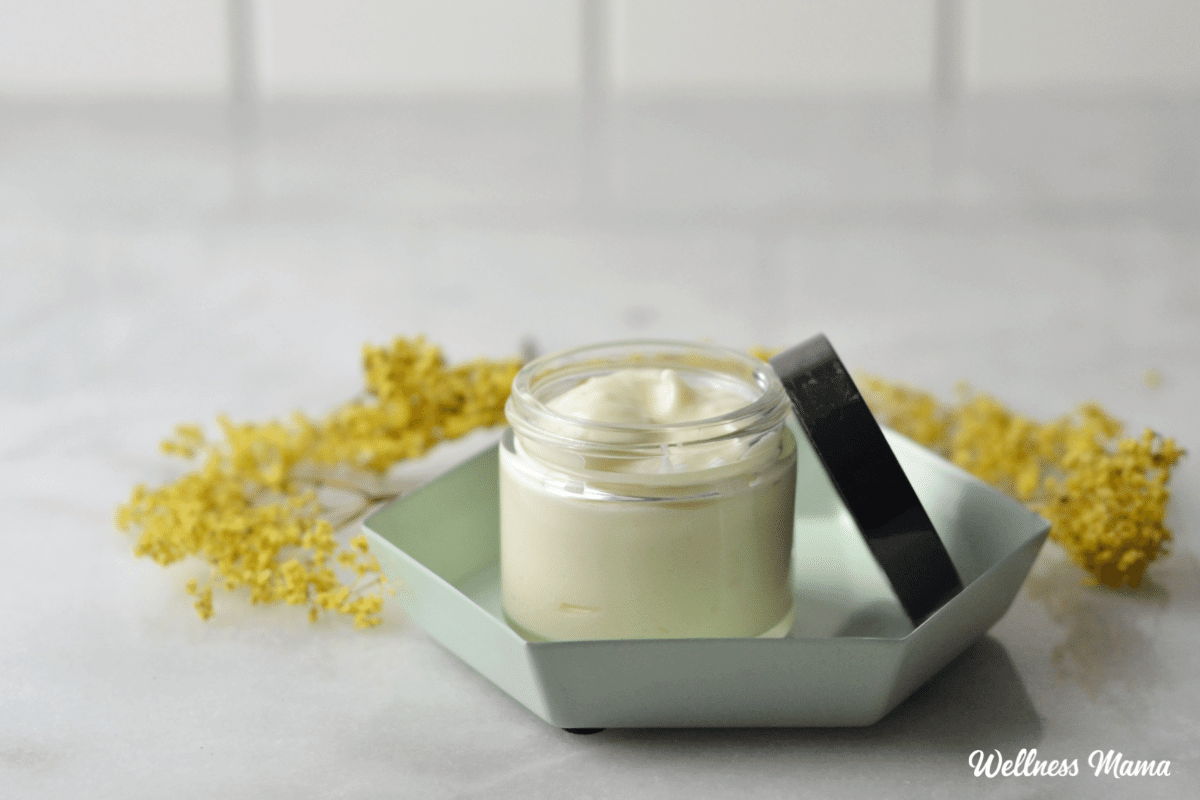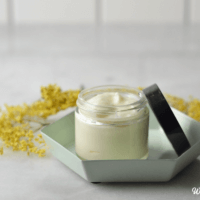Niacinamide (a form of vitamin B3) is a powerhouse ingredient for fighting inflammation and signs of aging. One of the best ways to harness its skin benefits is with a niacinamide cream. This lightweight face moisturizer glides on smoothly and leaves skin feeling nourished.
Niacinamide Moisturizer Skin Benefits
Here’s a quick overview of niacinamide’s benefits. Also known as vitamin B3, niacinamide can help with a whole host of skincare issues.
- Reduces inflammation
- Reduces fine lines and is anti-aging
- Improves dark spots and discoloration
- Suitable for both dry skin and oily skin
- Helps with blemishes and hyperpigmentation
- Helps with eczema and rosacea
- Good for acne-prone skin and breakouts
- Helps with brightening dull skin tone
- Minimizes pores
Mixing Niacinamide With Other Products
Hyaluronic acid toner works well with a niacinamide facial moisturizer. Some products even combine the two to stimulate collagen peptides for plumper skin. Vitamin C, however, does not work well with niacinamide and turns it into niacin, which can cause skin irritation.
Niacinamide moisturizer can fit nicely into your regular skincare routine. After using a cleanser and toner, apply the nourishing moisturizer for a more even skin tone. You can find niacinamide powder here.
Niacinamide Face Moisturizer Ingredients
Most of the niacinamide moisturizers on the market have a long list of ingredients. That’s not necessarily a bad thing, but when we’re making up a DIY face cream in the kitchen, less is often more. I kept the ingredients for this simple yet effective, and each one serves a purpose. We’ve already covered our star ingredient, niacinamide, but let’s take a closer look at some of the others.
Shea Butter
Normally I would choose non-comedogenic mango butter for a face cream, but this facial moisturizing lotion uses shea butter instead. Mango butter is high in vitamin C (a good thing!), but it can clash with niacinamide, causing irritation. Shea butter is high in vitamins, like the antioxidant vitamin E. This butter helps combat dryness and maintain elasticity.
Because of its unique plant compounds, shea butter helps protect against UV ray damage, although its exact SPF is unknown. It’s not a replacement for sunscreen, but I don’t use much sunscreen anyway. Get organic shea butter here.
Jojoba Oil
Technically jojoba is a wax, not an oil. This unique skincare ingredient closely mimics our skin’s sebum, so it absorbs beautifully. It draws moisture to the skin and helps our skin’s protective acid mantle. It’s good for all skin types, is an antioxidant, and is anti-inflammatory and anti-bacterial.
If your skin tends to be really dry, you could substitute olive oil or avocado oil instead. Get jojoba oil here.
Grapeseed Oil
I used grapeseed oil as the main oil in this niacinamide moisturizer recipe. It’s lightweight, won’t clog pores, and is good for a variety of skin types. If you don’t have any grapeseed oil on hand, then sweet almond oil will also work. You could also choose a heavier oil if you have very dry skin.
Waxes
This recipe uses both emulsifying wax and beeswax, and it’s important to use both. Emulsifying wax is vegetable-derived and helps to combine the oil and water. Without it, the oil and water don’t play nice together and make a watery, clumpy mess instead of a hydrating lotion.
Emulsifying wax, however, does not thicken the lotion and on its own makes for a very watery skincare product. The beeswax is necessary to turn the ingredients into a thick, creamy lotion. The shea butter helps to thicken it some, too, so we don’t need as much beeswax (which can clog pores). Get emulsifying wax and beeswax here.
Glycerin
I’ll sometimes make glycerin tinctures (called glycerites) for my kids instead of regular alcohol tinctures. And while you won’t find glycerin in my toothpaste, it’s great for natural skincare. Glycerin smooths, hydrates, and softens skin for that healthy glow. It works as a humectant to draw moisture to the skin, keeping it hydrated and plump. Get glycerin here.
Leucidal Complete Natural Preservative
This is a newer ingredient to some of my DIY skincare products but a very useful one. Because bacteria, fungus, and other microbes love water, a natural, paraben-free preservative helps the niacinamide moisturizer last longer. Unlike my products at Wellnesse that go through stability testing, DIY products don’t have any concrete guarantees on shelf life.
Adding 4% Leucidal to the recipe should make the lotion last for several months. Leucidal Complete is a broad-spectrum natural preservative that tackles a variety of opportunistic microbes and helps the lotion last longer. However, the moisturizer still needs to be stored properly, and as always, throw it out if it starts to smell or look off.
If you don’t want to use a preservative, then store the niacinamide moisturizer in the fridge and use it within two weeks.
Essential Oils
I use essential oils frequently in my home for mood-boosting, better sleep, and healthier skin. There are a lot of different options that will work in this face lotion. I used lavender because it’s gentle on skin and is good for blemishes of all kinds.
Here are some other skin-friendly essential oils that will also work:
- Frankincense
- Geranium
- Sweet orange
- Tea tree
- Carrot seed
- Helichrysum
- Patchouli
- Cedarwood
- Anti-age essential oil blend
Niacinamide Moisturizer Strength
I used 5% niacinamide powder in this recipe because 2-10% is what’s most often recommended by dermatologists. If you have really sensitive skin, you can cut the powder in half and still see some benefits. Some niacinamide products go up to 10% or more, but this is more likely to cause irritation.
This dermatologist recommends using a 10% niacinamide serum for spot treatments to help with severe blemishes. If you want to try that out, double the amount of niacinamide in the recipe. Keep in mind not everyone can tolerate that much, and less is often more.
How to Make Niacinamide Lotion
Don’t be intimidated by the different “phases” used in the recipe. Just like making healthy mayonnaise, the ingredients need to emulsify. All we’re doing is mixing together the oil-soluble ingredients in one step and the water-soluble ones in a different step. Once everything emulsifies together, we can add in the heat-sensitive ingredients.
Niacinamide Face Moisturizer
Equipment
- Stand mixer with whisk attachment
Materials
Oil phase
- 2 tsp shea butter
- 1 tsp jojoba oil
- 2 TBSP grapeseed oil
- 2 tsp emulsifying wax
- 1½ tsp beeswax pellets
Water phase
- 2 TBSP distilled water
- 5 tsp glycerin
Cool-down phase
- 1 tsp niacinamide powder
- ½ tsp leucidal complete preservative
- 20 drops lavender essential oil
Instructions
- Combine all the ingredients for the oil phase into the glass bowl.
- Fill a saucepan half full with water, and place the glass bowl on top to make a double boiler. Heat over high heat, stirring the ingredients occasionally until completely melted.
- While the oil-soluble ingredients are on the stove, mix the glycerin and water together in a separate glass jar. Set aside for later.
- Pour the melted ingredients from the stove into the stand mixer bowl, and put it in the freezer for about 5 minutes. You do not want this to freeze only cool down to room temperature. Once the oil mixture is cooled, it should look more opaque and have a thicker consistency.
- Put the bowl on the stand mixer with the whisk attachment on medium speed. Very slowly drizzle in the water mixture, and increase the speed to medium-high.
- Once the mixture looks like lotion, add in the cool-down phase ingredients and mix until well combined.
Notes
Have you ever used niacinamide (vitamin B3) in skincare products before? Leave us a comment and be sure to share this post with a friend!



Leave a Reply